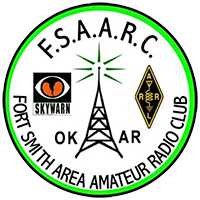The Fort Smith Area Amateur Radio Club serves Amateur Radio Operators, and those interested in Amateur Radio in the River Valley area of Western Arkansas and Eastern Oklahoma.
We are a friendly, active club open to anyone interested in Amateur Radio. Apart from the fun, we’re also actively involved in providing emergency communications and severe weather information to the local community.
Club meetings are every third Monday at 7:00pm at the Sebastian County Emergency Communications and Training Facility in Fort Smith. Check the events listing for locations and times. All are welcome to attend the meetings, we’re a very friendly club and love to see visitors at the meetings.
If you’re interested in joining the club, or becoming an Amateur Radio Operator, please contact one of our club officers below or drop us a note on the Contact Us page.
Our mailing address is:
FSAARC
PO BOX 32
FORT SMITH AR 72902-0032
FSAARC Club Officers
| Position | Name | Call |
| President | Dennis Robinson | WX5DR |
| Vice President | John Samuels | W5ATW |
| Secretary | Steve Rutherford | WC5SR |
| Treasurer | John Annis | WO0OOO |
| Weather Net Coordinator | Wayne Johnson | W5OFN |
| VEC Testing Coordinator | Steve Rutherford | WC5SR |
